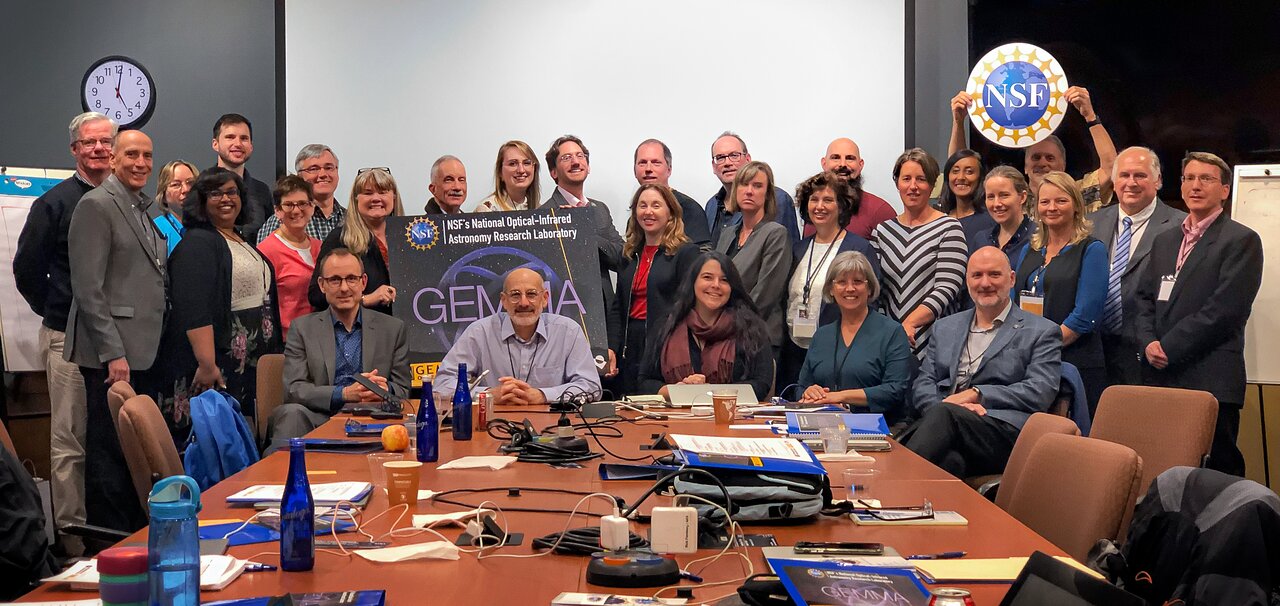Planning for a New Era in Astronomy Communication
November 20, 2019

In early November, the GEMMA (Gemini in the Era of Multi-Messenger Astronomy) project brought together science communications professionals to explore the unique opportunities and challenges of communicating Multi-Messenger and Time-Domain Astronomy, two rapidly growing fields in astronomy. Funded by the US National Science Foundation, this communications summit hosted more than 30 participants for two days at the Space Telescope Science Institute (STScI) in Baltimore, Maryland, an AURA-managed facility.
Until the mid-20th century, our view of the Universe was limited almost entirely to the narrow band of light that could penetrate the Earth’s atmosphere and was visible either to our eyes or to sensitive photographic plates loaded at the focus of increasingly large telescopes. The first major expansion of our view came with the development of radio astronomy, leading to the realization that the Universe could look very different when seen through different “eyes” tuned to a different type of radiation. Since then astronomers have studied the Universe at all wavelengths, and this more complete “multiwavelength” view of the Universe produced a wondrous and often breathtakingly beautiful picture of a Universe whose richness could not have been imagined.
However, over the past decade or so, discoveries have been made with “messengers” from space that go beyond photons, the messenger of light: particles from distant galaxies, neutrinos from the Sun and supernovae, and most recently ripples in the fabric of spacetime itself, known as gravitational waves. Multi-Messenger Astronomy is now the term we use when astronomers detect the same object or event with either light and particles, light and gravitational waves, particles and gravitational waves, or all three together (which has yet to occur). As the science in each of these three areas advances, these multi-messenger events will reveal an even more complete picture of the Universe and we will learn more about our cosmic history than any one of these individual types of signal, or messengers, can provide in isolation.
At the same time, a growing realization of the Universe’s dynamic nature has crept into astronomy. Things that “go bump in the night” are not new: comets, shooting stars and planets have been observed and discussed for millennia. However, by and large, our Universe has on larger scales seemed static and only evolving over cosmological timescales. Over the past decades, it has turned out that there is a lot more action than we thought, and sometimes on short timescales like days, hours, seconds or even less. Supernovae explode, stars change in brightness, novae flare, and outbursts occur in regions around black holes. Early in the 2020s, the Large Synoptic Survey Telescope (LSST), funded mainly by the NSF and DOE, will begin a ten-year mission to produce a deep, wide, multi-band photometric map of approximately half the sky. The LSST is expected to yield 10 million transient “alerts” for such changing phenomena each clear night, ushering in a golden age for Time-Domain Astronomy.
The traditional way of doing astronomy — where individual astronomers travel to a telescope, take a spectrum of a galaxy and then go home and analyze it — will remain an option, but chances are that the big discoveries will be made by big-science infrastructures in big collaborations, and possibly increasingly in new areas like Multi-Messenger and Time-Domain Astronomy. As ordinary matter only accounts for up to 5% of the Universe, the remaining 95% is largely undiscovered. Who knows what kind of new physics will come out of these two up-and-coming areas of astronomy, and this involves tremendous opportunities, but also challenges, for science communicators. At the same time, it is also clear that the communication needs of our society and its citizens have changed.
Participants in the GEMMA summit engaged in wide-ranging discussions, from the establishment of libraries of shared communication resources and protocols for press releases and media communications, to the possibility of a professional network for those involved in the communication of Multi-Messenger and Time-Domain Astronomy. Participants also shared their expertise with in-depth presentations on topics such as: the scientific future of Multi-Messenger and Time-Domain Astronomy; what to anticipate once the Large Synoptic Survey Telescope (LSST) is operational; the challenges of traditional print media; science communication via social and new media; and many of the lessons learned from past communications on Multi-Messenger and Time-Domain Astronomy discoveries.
The GEMMA team and staff of the NSF extend a special thanks to STScI for their critical help with logistics and facility coordination. The GEMMA program is funded by an award from the National Science Foundation to advance the leadership role of Gemini Observatory in the era of Multi-Messenger Astronomy. The program is designed to maximize synergies with the transformative facilities coming online in the near future. The projects within GEMMA specifically focus on the areas of high spatial resolution, rapid-response astronomy and communications. Gemini is part of NSF’s National Optical-Infrared Astronomy Research Laboratory which has recently launched.
Links
Contacts
Peter Michaud
Head of NewsTeam
NSF’s National Optical-Infrared Astronomy Research Laboratory
Tel: +1808-974-2510
Cell: +1 808 936-6643
Email: pmichaud@gemini.edu
